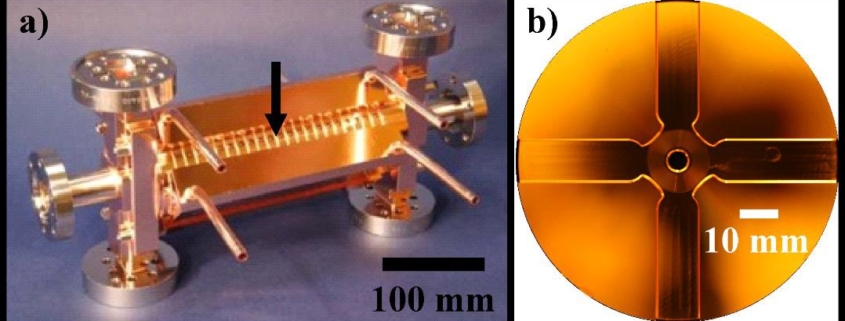Length calibration of Fourier domain interferometer for particle accelerator quality assurance
PERMALINK
http://urn.fi/URN:ISBN:978-951-51-2786-0
| Title: | Length calibration of Fourier domain interferometer for particle accelerator quality assurance |
| Author: | Montonen, Risto |
| Date: | 2018-08-14 |
| ISBN: | 978-951-51-2786-0 |
| URI: | http://hdl.handle.net/10138/238000 http://urn.fi/URN:ISBN:978-951-51-2786-0 |
Following development of the Large Hadron Collider at CERN (European Laboratory for Particle Physics), a viable option for the future frontiers of particle physics would be the Compact LInear Collider (CLIC). For efficient collider operation, the internal alignment and shape of the particle accelerating structures is crucial, as even micrometer-level misalignments reduce the performance of CLIC. Destructive quality assurance methods exist that require cutting the structure into two halves but prevent subsequent use of the accelerating structure.
I propose a fiber-optic Fourier domain short coherence interferometer (FDSCI) for quality assurance of the accelerating structure. The method provides submicron accuracy, 10 mm measurement range, and nondestructive access inside the hard-to-reach accelerator cavity.
The method relies on length calibration that employs transparent plate transfer standards of a certified geometric thickness. FDSCI actually measures the optical thickness, and these two lengths are related to each other through the group refractive index. In this thesis the group refractive index of the transfer standards was quantified using a balanced Sagnac type interferometer. The calibration provided a function that can be used to correct the bias in the measurement system. The concept was validated by measuring a step profile on a copper disc manufactured to the same tolerances that are required from the accelerating structures. Uncertainty analysis, including contributions from the calibration, measurement repeatability, sample orientation, environmental conditions, and thermal expansion, showed that submicron accuracy was achieved at a 95% confidence level.
A fiber-optic probe provided access inside the accelerator cavity. The probe operates in common-path configuration which automatically compensates for the dispersion in the optical system, thus maintaining the achieved accuracy. The required 10 mm measurement range was achieved by employing a tunable Fabry-Perot filter assisted spectral interferogram acquisition technique.
The fiber-optic FDSCI shows promise in quantifying whether the accelerating structures are assembled to the required tolerances.
Euroopan ydinfysiikan tutkimusjärjestö (CERN) on suunnittelemassa uutta CLIC-törmäytintä (Compact LInear Collider). Toimiakseen tehokkaasti, CLIC-törmäyttimen kiihdytinelementtien tarkka sisäinen linjaus ja muoto ovat välttämättömiä, koska jopa mikrometri-luokan kokoamisvirheet laskevat törmäyttimen suorituskykyä. Olemassa olevat laadunvarmennusmenetelmät, joissa kiihdytinelementti avataan kahtia halkaisemalla, eivät käy, sillä ne estävät elementin käytön testauksen jälkeen.
Tässä väitöskirjassa minä ehdotan kiihdytinelementtien laadunvarmennusmenetelmäksi kuituoptista lyhyen koherenssin interferometriä, joka tarjoaa samanaikaisesti sekä alle mikrometrin tarkkuuden 10 mm mittauskantamalla että rikkomattoman pääsyn kiihdytinelementin sisälle.
Mittalaitteen tarkkuus perustuu kalibrointiin, joka suoritetaan sertifioiduilla läpinäkyvillä mittapaloilla. Todellisuudessa optinen mittalaite mittaa optisia paksuuksia, jotka vertautuvat geometrisiin mittoihin kappaleen taitekertoimen kautta. Tässä työssä käytettyjen mittapalojen taitekertoimet määritettiin tasapainotetulla Sagnac-tyyppisellä interferometrillä. Kalibroinnista saadun korjauskertoimen avulla mittalaitteen mittausvirhe saadaan korjattua. Menetelmän käyttökelpoisuus vahvistettiin mittaamalla porrasprofiili kuparinäytteestä, joka oli työstetty samoilla toleransseilla, joita vaaditaan kiihdytinelementeiltä. Epävarmuuslaskelma, jossa otettiin huomioon kalibroinnista, mittauksen toistettavuudesta, näytteen asettelusta, mittausolosuhteista ja lämpölaajenemisesta aiheutuvat virhelähteet, osoitti, että mittalaite kykenee alle mikrometrin tarkkuuteen 95% luottamusvälillä.
Kiihdytinelementin sisälle, sitä rikkomatta, päästään kuituoptisella mittapäällä. Mittapää hyödyntää interferometrista yhteispolkutekniikkaa, joka automaattisesti kompensoi dispersion vaikutuksen optisessa systeemissä, säilyttäen siten saavutetun tarkkuuden. Vaadittu 10 mm mittauskantama saavutettiin käyttämällä kapeaa ja säädettävää Fabry-Perot suodatinta spektri-interferogrammin näytteistyksessä.
Tässä väitöskirjassa kehitetty kuituoptinen lyhyen koherenssin interferometri on lupaava mittalaite CLIC-törmäyttimen kiihdytinelementtien kokoamisen laadunvarmennukseen.


